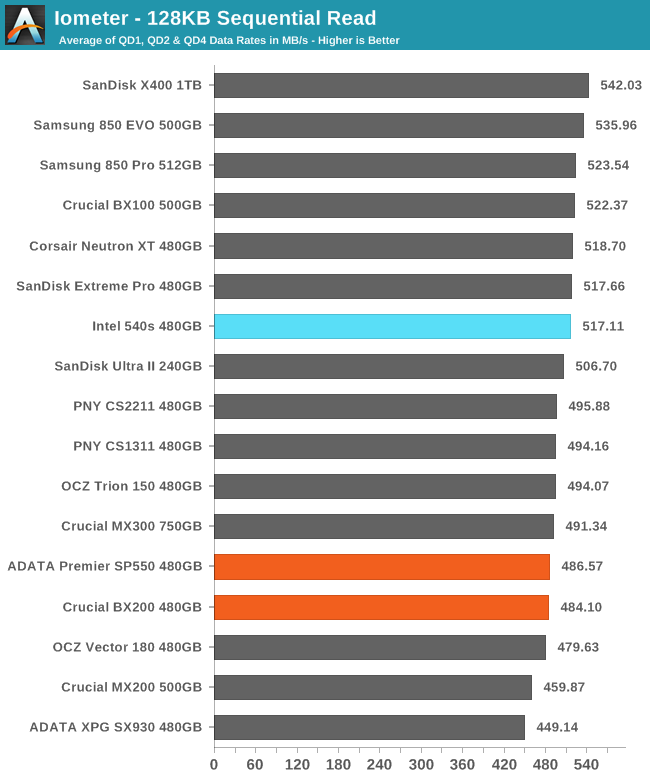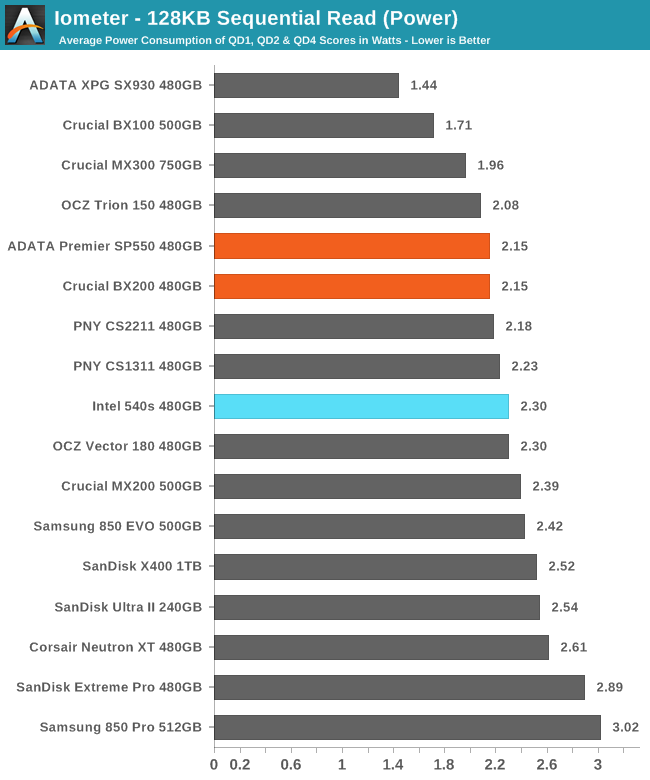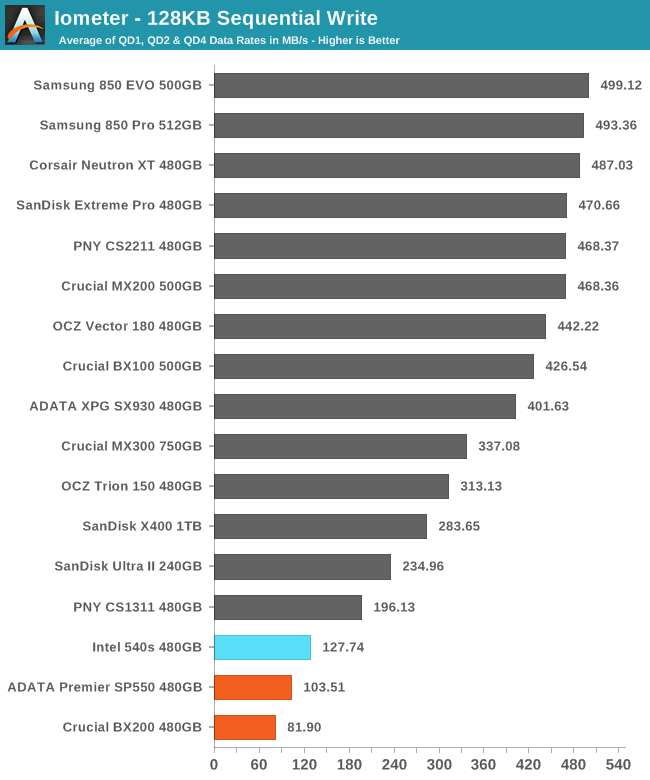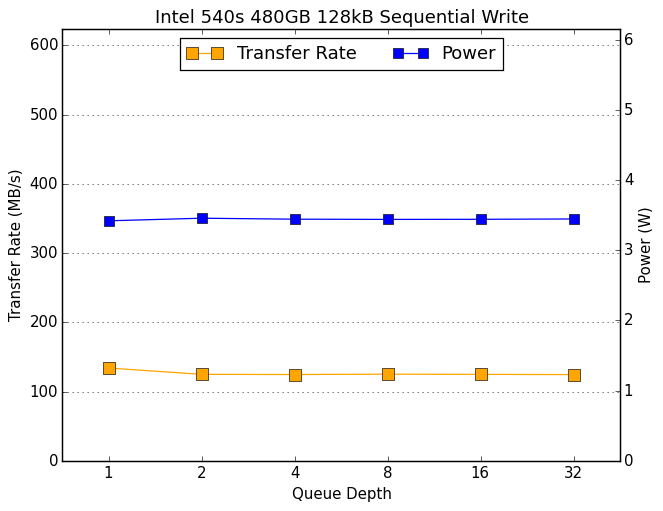The Intel SSD 540s (480GB) Review
by Billy Tallis on June 23, 2016 9:00 AM ESTSequential Read Performance
The sequential read test requests 128kB blocks and tests queue depths ranging from 1 to 32. The queue depth is doubled every three minutes, for a total test duration of 18 minutes. The test spans the entire drive, and the drive is filled before the test begins. The primary score we report is an average of performances at queue depths 1, 2 and 4, as client usage typically consists mostly of low queue depth operations.

Sequential read performance of SATA drives continues to be pretty boring. The Intel 540s scores better than any other planar TLC drive, but the spread of scores is still quite small.

Power consumption shows much more variability than performance for sequential reads, and the 540s is a little less efficient than the SM2256 drives here.
 |
|||||||||
For most drives, their ranking is determined by their QD1 performance as at higher queue depths almost all drives are saturating the SATA link. The Intel 540s has very good QD1 performance, but doesn't make it all the way to peak performance until the queue is at the full depth of 32.
Sequential Write Performance
The sequential write test writes 128kB blocks and tests queue depths ranging from 1 to 32. The queue depth is doubled every three minutes, for a total test duration of 18 minutes. The test spans the entire drive, and the drive is filled before the test begins. The primary score we report is an average of performances at queue depths 1, 2 and 4, as client usage typically consists mostly of low queue depth operations.

The Intel 540s manages to significantly improve on the greatest weakness of the SM2256 drives, but the sequential write speed it delivers is still much worse than any of the other competition.

The power usage of the Intel 540s is higher than the SP550 by enough that efficiency actually regressed a tiny bit, but they're both quite inefficient given how much slower they are than the competition.
 |
|||||||||
The Intel 540s shows essentially no dependence between sequential write speed and queue depth, which is not uncommon.










77 Comments
View All Comments
Notmyusualid - Thursday, June 23, 2016 - link
Ya saved me from writing it...shelbystripes - Thursday, June 23, 2016 - link
Intel is considered a reliable brand to OEM PC makers and other bulk purchasers. Offering a low-end part means capturing business that might go to a second-tier manufacturer. For builders with a use case where any modern SSD is fast enough, and you care about reliability without breaking the bank, this will be the #1 choice. You get the Intel name and the things INCLUDED with that, like solid customer support and timely firmware updates, at a lower price point.Nobody buying this is expecting it to be a performance part. Intel is the company that sold Celerons with no L2 cache, that sells cut-down Atom CPUs and Core CPUs under the same Pentium brand name. Intel doesn't always mean performance. It does mean confidence that what you're buying actually works, though.
BurntMyBacon - Friday, June 24, 2016 - link
@shelbystripes: "Offering a low-end part means capturing business that might go to a second-tier manufacturer. For builders with a use case where any modern SSD is fast enough, and you care about reliability without breaking the bank, this will be the #1 choice."You know, Intel used to cater to this market, ... , with their 300 series drives. Interestingly, the relative performance of this drive matches up to where their 300 series used to slot in as well. Why is this not a 300 series drive?
vladx - Friday, June 24, 2016 - link
My tablet running an Atom quad-core works great. To compare this joke of a SSD from Intel to that is a fucking joke.plopke - Thursday, June 23, 2016 - link
Won't the 540 be shortlived? Shouldn't we be seeing 3d nand drives of intel soon followed by optane?https://i0.wp.com/benchlife.info/wp-content/upload...
A5 - Thursday, June 23, 2016 - link
This is for a different market segment.Billy Tallis - Thursday, June 23, 2016 - link
That roadmap shows the 540s sticking around at least through Q1 2017, and merely being joined by some Optane and 3D TLC NVMe drives. The actual replacement of the 540s is at an indefinite point in the future.The determining factor will be how long it takes 3D NAND to get cheap enough to displace 15/16nm TLC. I don't think that will be happening any time soon; even Samsung apparently can't pull it off yet, since they introduced the 750 EVO.
Mobile-Dom - Thursday, June 23, 2016 - link
IIRC Samsung used planar NAND in the 750 because they wanted lower capacity without the performance degradation, as by using the high layered 3D NAND they used fewer packages resulting in worse performance for drives that had 1 or 2 packages for the entire SSDextide - Thursday, June 23, 2016 - link
Nah, both their planar 15/16nm and their 3D NAND use 128Gb dies -- so same amount of dies in either product. It's purely a cost thing. It will probably take until we get into the 100+ layers of 3D NAND for it to be competitive, cost wise, with that 15/16nm planar TLC.Billy Tallis - Thursday, June 23, 2016 - link
That's what they said at first, but then they introduced a 500GB 750 EVO while the 850 EVOs on the market are still using the 32-layer VNAND.